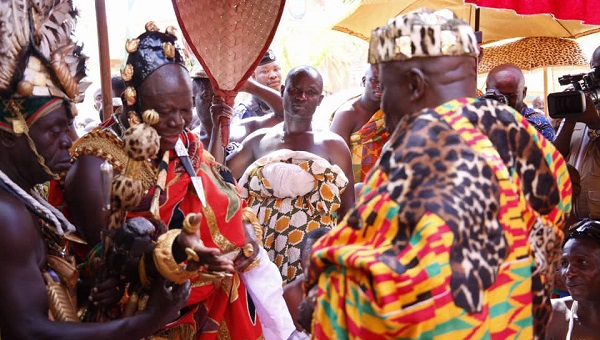
We stand for unity - Okyenhene, Asantehene declare
It was not readily expected, but yesterday arguably the two most powerful chiefs in the country met in the ancient and serene town of Kyebi, located on the eastern slopes of the Atewa Range, at a grand durbar to commemorate the 75th anniversary of the passing of Nana Sir Ofori Atta I.
Nana Sir Ofori Atta I reigned as Okyenhene from 1912-1943 and has been described as the father of modern Akyem Abuakwa.
Advertisement
Dubbed the Nkabom Durbar, to wit, unity gathering, the event showcased the pomp and circumstance of the rich Ghanaian culture, with majority of the guests apparelled in Ghana’s rich Kente of different designs.
The durbar was attended by dignitaries, including President Nana Addo Dankwa Akufo-Addo and his wife, Rebecca; former President J.J. Rawlings and his wife Nana Konadu; the Speaker of Parliament, Professor Aaron Mike Oquaye; the Majority Leader, Mr Osei Kyei-Mensah-Bonsu, Members of Parliament (MPs), ministers of state and captains of industry.
Views
The people whose views were sampled by the Daily Graphic thanked the architects of the Nkabom Durbar, especially as it came in the wake of perceived rivalry between Asantes and Akyems in recent times.
The perceived rivalry reached a crescendo when the Asantehene, Otumfuo Osei Tutu ll, raised his voice against certain people considered to be part of the Akyem mafia who were bent on derailing his kingdom.
It took the intervention of President Akufo-Addo to douse the flames.
Shortly thereafter, the Okyenhene, Osagyefuo Amoatia Ofori Panin, paid a visit to Kumasi to participate in the Otumfuo Golf Tournament.
On that occasion, the two chiefs played golf together and had dinner, with the President in attendance. That meeting began to set the tone for the strengthening of ties between the two chiefs.
Then came the news that Otumfuo Osei Tutu was to be the special guest of honour at the grand durbar at Kyebi to mark the 75th anniversary of the passing of Nana Sir Ofori Atta.
The first visit by an Asantehene to Kyebi was in 1742. It is also on record that when Nana Sir Ofori Atta I became a member of the Joint Provincial Council of Chiefs, he played a major advocacy for the return of the Asantehene Osei Agyeman Prempeh from exile in The Seychelles.
Culture
Yesterday was long in coming, but when the day finally dawned, there was no leg room in the vicinity of the Ofori Panin Fie at Kyebi, or more specifically at Ese Ho, the durbar ground.
The official programme line-up put the commencement of activities at 11 a.m., but the large crowd had patience to wait for the beginning of the programme at 2 p.m.
During the interregnum, the rich culture of Akyems and Asantes and, indeed, Ghana was on display.
Then at noon the chiefs from Ashanti started making their way to the durbar ground, amid drumming and dancing and the firing of muskets by the Asafo groups of the various chiefs.
A few minutes after 1 p.m., the Okyenhene, at the rear of a long line of chiefs, started making his way from the Ofori Panin Fie to the durbar ground.
When he got closer to the durbar ground, a little boy sitting in the Okyenhene’s palanquin caught the attention of the crowd with his beautiful gestures in response to Fomtomfrom and Adowa.
The procession of the Asantehene was equally majestic, with the Otumfuo stopping at intervals to dance, amid cheers from the crowd.
Perhaps the most significant Kente on display was the one worn by the Asantehene, which symbolised unity.
He wore the same Kente cloth that Nana Osei Agyeman Prempeh I, a former Asantehene, wore in 1935 when he unified all the various traditional areas of Asante.
In addition to the rich display of significant aspects of Ghanaian culture, all the activities that took place at the event had the central theme of unity.
The traditional dancing, drumming, appellations to chiefs and the other aspects of custom on display all added to the theme of unity that characterised the event.
Climax
The durbar reached its climax when the Asantehene descended from his palanquin to embrace the Okyenhene, to thunderous cheers, to rekindle the bond of friendship between the two powerful traditional rulers.
The Asantehene was accompanied by 24 paramount chiefs and a delegation of about 2,000 people from the Ashanti Region.
When the function was over, there was a gridlock in Kyebi, with the two entry and exit points of the town no go areas.
The day was for the Okyenhene and the Asantehene, and when the two chiefs had the opportunity to speak, they dismissed the perception that the two ethnic groups did not see eye to eye with each other.
Love and unity
The two traditional leaders, in their respective speeches, reaffirmed the strong love between the two ethnic groups.
They said the two groups were the same, as they migrated from the same area and their leaders had constant interaction.
The Asantehene, for his part, used the opportunity to thank Akyems for the advocacy role that Nana Sir Ofori Atta I played to seek the return of Nana Sir Osei Agyeman Prempeh from exile.
“We are all one people; there is no difference between us,” he added.
The Okyenhene equally thanked the Asantehene for the ties that had existed between the two ethnic groups.
“Okyeman and Asanteman have always dwelt together as one people,” he said.




